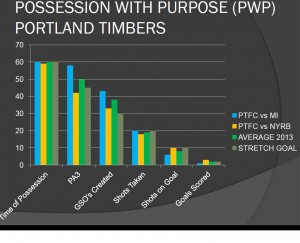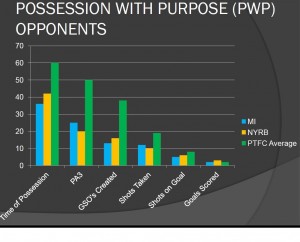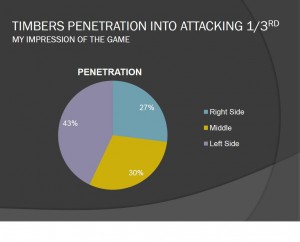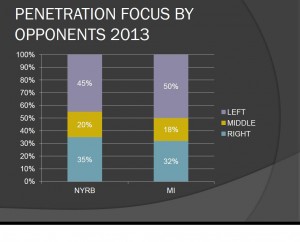Portland Timbers – Evaluating the Impact of Montreal

Defense First; this is a tried and true method to minimize risk and maximize opportunity for at least one point in any game of soccer. John Spencer advocated he would leverage direct attacking football to get three points. He failed and got sacked last year because of that.
Caleb Porter has come in and advocated control and possession with purpose (his attacking style / focus) in order to get three points.
Two games in (at home) and PTFC have 1 point out of a possible 6.
Bottom line in soccer is that getting a clean sheet “first” will also set a team up for success in getting three points. The hard nut to crack is finding the right balance to maximize attack while minimizing risk.
An expectation that the magic begins on day one is unrealistic; I’m not impatient on this one but early trends indicate this approach may be sacrificing a wee bit too much.
Caleb has indicated this will take time; I agree.
That said the nuts and bolts of this game provide a great example where risk outweighed reward.
Again a goal conceded by PTFC came from a set-piece; set-pieces WIN games. All the control in the world has no final bearing in a game where possession is 50/50, 40/60, or 60/40 when one play, in a matter of seconds, can result in a goal scored.
I did mention to @futboldaddy in the press box about 5 seconds before that goal that it looked like PTFC were ball watching – with that – a follow-on ball from the set-piece found two unmarked Impact players in the box while others watched on — seconds later Camara drove home a brilliant wheel-kick strike.
Complacency is a word that comes to mind when seeing how that goal was scored against Portland.
There is no excuse to even begin to think that just because you control the majority of possession “means” you are entitled to ‘watch’ others while the game is played in your defensive third. A team is not going to win games if it concedes goals.
In the second half Michael Harrington (left fullback) played a pass to Will Johnson (58′:56″ on your DVR) who looked to push the ball forward up the inside while Harrington basically ‘took-off’ sprinting down the left wing.
Unfortunately Johnson’s pass was errant, a turnover occurred, and a counterattack began with Harrington way out of position on his left (risk versus reward!).
Caught flat footed, Harrington pretty much ball watched as Romero made a run down his wing, beat a slower Silverstre to the ball, tucked a nifty drop-back pass to the top of the 6 where a trailing Felipe slotted home the winner.
Again, complacency, and a reasonable ‘intuitive’ conclusion that Harrington felt he was ‘entitled to ball watch’ because he was pushing forward (doing his job in attack) when the reality is he’s on the pitch to defend first.
So what about Possession with Purpose; the attacking numbers again were outrageous. Here’s the diagram showing the stats as they accumulated this game compared with New York, PTFC’s average this year (to date) and a ‘stretch target’.
Observations / thoughts…
1. In every category barring Shots on Goal and Goals scored Portland exceeded the stretch targets I offered up as being a great indicator on what level of attacking football might be needed to get this team in the MLS Playoffs.
2. So what happened? Bottom line here is that Montreal stacked and loaded the 18 yard box with 8, 9 0r even 10 field players as Portland penetrated the attacking third.
3. Pretty much nullifying all the time and energy Portland devoted to controlling the game by simply shutting down passing lanes and clogging the lower midfield.
4. Proof that a great defensive scheme beat the attacking scheme of Portland this game. I won’t offer that Portland needs better strikers or forwards here; Portland needs better and quicker decision making in ‘what to do with the ball’ when they get it in there.
This is the second game of the season and PWP is just as important to track for our opponents as it is Portland. Here’s how the numbers appear for New York and Montreal in comparison to the PTFC average thus far this season.
Bottom line here is that even with overwhelming evidence that Portland is kicking arse when it comes to possession they are not winning the battle on possession with purpose; where purpose is to score goals and get three points.
Both teams came into Portland to counterattack and take advantage of mistakes in set-pieces; both teams were successful in their approach.
Tactical adjustments need to be made to shake this early trend.
While this is only two games worth of data if may be an early indicator of how things may play out with home games.
It will be interesting to see how these stats add up for away games and then see what comparisons there are between home and away games. More to follow….
So what about penetration; where did Portland and Montreal penetrate the most?
A key focus area offered up in my preview was to try and penetrate down the PTFC left side to try and get Nesta pulled out wide. While Portland did penetrate that area, more than any other area, they were never successful in getting Nesta out wide.
Here’s the snapshot from OPTA indicating ball distribution, possession, and defensive activity by Nesta and Ferrari; note the huge blank area of activity for Nesta in their defending right back area.
Seems to me that is pretty much what it looked like when Montreal played Seattle. Here’s a reminder of their ball distribution, possession and defensive activity against Seattle.
So what about Montreal; where did they penetrate and how does that stack up to where New York penetrated?
Like New York the majority of penetration into the Portland defending third was down our left wing. Goals scored, in both cases, got their original start with penetration down that side this game.
It’s unclear if this is a trend yet but knowing the behavior of the opponents should help understand where Portland may have unrecognized weaknesses. It will be interesting to see how this diagram unfolds as the season progresses.
Final thoughts:
1. Crosses and crossing, I may have missed it but I don’t recall seeing Miller offer up any crosses on the right side apart from once. While I have offered that he needs to get better; he isn’t going to get better unless he tries to execute them in a game.
2. Crosses and crossing, PTFC only offered up four crosses (that I saw) in the 1st half; three of which came from Ryan Johnson.
3. By contrast in the 2nd half PTFC provided 16 crosses; with a cracker by Zemanski getting Ryan Johnson his first goal this year.
4. Putting in crosses against a team packing the 18 yard box has value; they create deflections, rebounds and all sorts of other opportunities – especially when the 18 is packed with bodies.
5. Slow… others may have a different view but I thought the reaction time and ‘touch’ by many players on Portland was just a wink to slow last night. When there is space and two players in the 18 yard box put the bloody cross in.
6. Fullbacks – Given the excessive penetration both high and low by the Portland fullbacks last night I wonder why I even call them ‘fullbacks’ as opposed to ‘wing-backs’. For the better part of this game last night Portland didn’t have a ‘back-four’ they had a ‘last-f0ur’ and the only two consistent players in that ‘last-four’ were Silvestre and Baptists.
7. Perhaps we see a more conservative and traditional 4-4-2 manifest itself next week versus Seattle? Nagbe rotates in as the #10 and Valeri works alongside Chara, Johnson, and Zemanski in the midfield?
9. A clean sheet has to be a priority against the Sounders next week!
Click “recommend” if you enjoy my statistical analysis approach to tracking success of the Portland Timbers this year.
You can follow me on twitter here …




